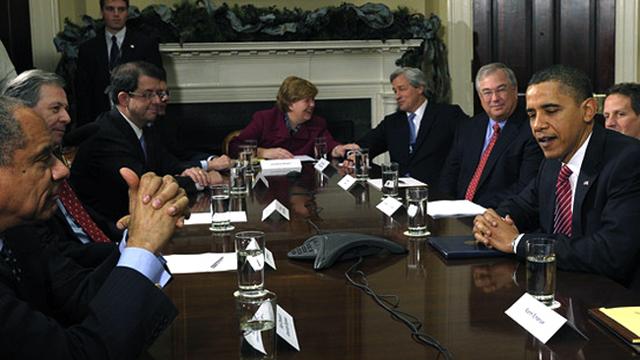
One thing you can say about the financial industry: it has no sense of loyalty.
Back in 2008, most of the biggest contributors to presidential candidate Barack Obama were financial companies. According to the campaign fund tracking website Open Secrets, after the $1.65 million donated by a political action committee (PAC) for the University of California, the next biggest contributor was a PAC for the giant bank, Goldman Sachs, whose employees ponied up a reported $1 million.
Right up there among the top contributors to the Obama campaign that year were two other of the nation’s top banks too: JP Morgan Chase, whose employee PAC gave $809,000, and Citigroup, which gave $737,000.
Two more big banks, UBS and Morgan Stanley, as well as General Electric, which less than a year later bought a bank to enable itself to benefit from the government’s largesse in doling out billions of “rescue” dollars under the Troubled Assets Relief Program (TARP), were among Obama’s top 20 campaign donors, handing over $533,000, $512,000 and 530,000 respectively to support his election.
Obama, after winning the presidency, repaid all that campaign largesse, appointing bank industry lackeys and executives to top positions. He made Timothy Geithner, who as head of the New York Federal Reserve branch during the Bush administration had ignored the scandalous derivatives scandals that brought on the financial crash, his Treasury Secretary; and Lawrence Summers, who as Treasury Secretary under President Bill Clinton had pushed for the deregulation of derivatives and for allowing banks to merge with investment banks -- and who, during the Bush years, earned millions as a consultant to the hedge fund industry and from speaking fees provided by Wall Street banks -- got the post of head of Obama’s Council of Economic Advisors.
Meanwhile, GE’s chairman and CEO, Jeffrey Immelt, who famously exported thousands of GE jobs abroad, was given the post of White House Jobs “Czar.”
Given the ease with which the Obama administration allowed the financial industry to subvert the Congressional legislation designed to reform the banking industry in the wake of the financial crisis of 2008-9, and the White House decision not to prosecute a single bank executive for the wholesale destruction of the U.S. and global economy, one might think that Wall Street would have rewarded Obama with more money for his re-election campaign.
Instead the industry, seeing even more advantage in having a Republican in the White House, and particularly one of its own — venture capitalist and multi-millionaire Mitt Romney — has switched its support over to his opponent.
Open Secrets reports that this year there is only one Wall Street bank listed among Obama’s top 20 largest donors: Wells Fargo, which only gave the president’s re-election campaign a scant $202,000, less than half what the smallest of his top 20 donors gave four years ago. Over all, big banks gave Obama over $4 million in 2008, and only $200,000, or just five percent as much, in 2012.
Romney, meanwhile, this year is awash in Wall Street money, and his donations are even bigger than the donations Obama received from the industry back in 2008. Romney’s number one donor is Goldman Sachs, the turncoat institution that gave Obama $1 million four years ago. Its PAC this year as of August had already given Romney almost $900,000. More importantly, the top eight biggest donors to Romney’s campaign were Wall Street financial institutions.
Number two on the list, Bank of America, gave $668,000. Number three, JP Morgan Chase, gave $663,000. Number four, Morgan Stanley, gave $650,000. Number five, Credit Suisse Group (where Romney reportedly stashes some of his money outside the U.S. and the prying eyes of the Internal Revenue Service), gave $554,000. Citigroup, his sixth biggest contributor, gave $554,000. Wells Fargo, number seven on the Romney donor list, gave $415,000, or more than double the amount given to the Obama campaign. And number eight, Barclays, the bank at the center of the LIBOR- rigging scandal in Britain, gave $404,000.
Also on Romney’s to 20 donor list are the hedge funds HIG Capital and the Blackstone Group, giving $338,000 and $309,000, respectively, the Swiss bank UBS, which was the center of a whistleblower-exposed scandal involving helping wealthy Americans hide income from the IRS which donated $308,000, Bain Capital, the venture firm owned and run, until recently, by Romney, which donated $268,000, and GE, now a banking firm, which gave $214,000.
In total, the banks that are among Romney’s 20 largest donors, had, through August, contributed a total of over $5 million to his campaign. Adding in other financial companies in that premiere list of donors, Wall Street firms alone gave his campaign over $6.2 million. The figure is surely considerably higher two months later in the campaign.
This year, meanwhile, having lost the banks, Obama is down to being the candidate of University administrators and faculty. His largest donor this year is the PAC for the University of California, which gave his campaign $707,000. U of C is one of six university PACs that dominate the list of Obama’s 20 largest donors, with his alma mater of Harvard being the second largest of the group and the fourth largest donor to the campaign overall at $434,000.
Other large donors to the Obama campaign are Microsoft, which gave $544,000, Google, which gave $526,000, IBM, which gave $219,000, the health insurer Kaiser Permanente, $316,000, entertainment conglomerate Time Warner $295,000, and several U.S. government employee PACs, which collectively gave close to $600,000.
Given these numbers, it seems clear, in case anyone needed a clue, that quarter-billionaire Mitt Romney is the candidate of Wall Street this year. As for Obama, Wall Street’s man in 2008, he may have to content himself with being the higher education candidate this year.
Dave Lindorff is a founder of This Can’t Be Happening and a contributor to Hopeless: Barack Obama and the Politics of Illusion.
3 WAYS TO SHOW YOUR SUPPORT
- Log in to post comments











